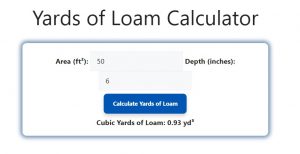About Yards of Loam Calculator (Formula)
Loam is a versatile soil mixture that combines sand, silt, and clay, making it ideal for gardening, landscaping, and construction projects. Understanding how much loam you need is crucial for successful planting and soil management. The Yards of Loam Calculator simplifies this process, enabling users to quickly determine the quantity required based on their project specifications. In this article, we will discuss the formula for calculating cubic yards of loam, how to use the calculator, provide a practical example, and answer frequently asked questions regarding loam calculations.
Formula
The formula for calculating cubic yards of loam is:
Cubic Yards of Loam = (Area * Depth / 12) / 27
Where:
- Area is the surface area in square feet where the loam will be applied.
- Depth is the desired depth of the loam in inches.
How to Use
- Measure the Area: Determine the area in square feet where you intend to apply the loam.
- Decide on the Depth: Determine the depth of the loam you want in inches.
- Insert Values into the Formula: Use the values you have measured for area and depth in the formula.
- Calculate: Perform the calculation to find the cubic yards of loam required.
Example
Suppose you have a garden bed that is 10 feet long and 5 feet wide, and you want to add 6 inches of loam to improve the soil quality. First, calculate the area:
Area = Length * Width = 10 feet * 5 feet = 50 square feet
Now, using the desired depth of 6 inches in the formula:
Cubic Yards of Loam = (Area * Depth / 12) / 27
Cubic Yards of Loam = (50 * 6 / 12) / 27
Cubic Yards of Loam = (50 * 0.5) / 27
Cubic Yards of Loam = 25 / 27
Cubic Yards of Loam ≈ 0.93
In this example, you would need approximately 0.93 cubic yards of loam for your garden bed.

FAQs
- What is loam?
Loam is a balanced mixture of sand, silt, and clay that provides optimal conditions for plant growth. - Why is loam important for gardening?
Loam retains moisture and nutrients while allowing for good drainage, making it ideal for gardening. - How do I measure the area for my project?
Measure the length and width of the area in feet and multiply them to find the total area in square feet. - What depth should I use for applying loam?
The depth depends on your project’s requirements, but 2 to 6 inches is typically recommended for gardening. - Can I use this calculator for other soil types?
Yes, while the calculator is designed for loam, it can be adapted for other soil types with appropriate adjustments. - How many cubic yards are in a cubic foot?
There are 27 cubic feet in one cubic yard. - What if I want to convert my measurements to cubic meters?
You can use conversion factors (1 cubic yard = 0.7646 cubic meters) to convert your results. - Is there a minimum depth for applying loam?
Generally, at least 2 inches is recommended to ensure effective soil improvement. - How often should I replace the loam?
This depends on usage and erosion, but replacing loam every 2 to 3 years is a good practice for gardens. - What tools do I need to measure area and depth?
A tape measure and possibly a ruler or level for depth measurements will suffice. - Can I apply loam in the winter?
Yes, but it’s best applied in the spring or fall for optimal planting conditions. - How do I distribute the loam evenly?
Use a rake to spread the loam evenly across the area after applying it. - What if my area has an irregular shape?
Break it down into smaller rectangular sections, calculate each area, and sum them up. - Is loam expensive?
Costs can vary based on location and supplier, but it is generally affordable compared to other soil types. - Can I use loam for potted plants?
Yes, loam can be used in pots, but mix it with other soil types for better drainage. - What is the best time to apply loam?
Early spring or fall is ideal for applying loam as it prepares the soil for planting. - Do I need to compact the loam after application?
Lightly compacting it can help settle the soil, but avoid over-compaction which can hinder root growth. - What are the signs I need more loam?
Signs include poor drainage, plants struggling to grow, or visible erosion in the area. - Can I mix loam with other materials?
Yes, mixing loam with compost or peat moss can enhance its fertility and moisture retention. - Is there a maximum depth for applying loam?
While there is no strict maximum, applying more than 6 inches may lead to drainage issues, so it’s best to consult local guidelines.
Conclusion
The Yards of Loam Calculator is an invaluable tool for homeowners, gardeners, and landscapers seeking to enhance their soil quality. By understanding the formula and applying it correctly, you can efficiently determine the quantity of loam needed for your project. With this knowledge, you can create a healthier environment for your plants and ensure your gardening endeavors are successful.
